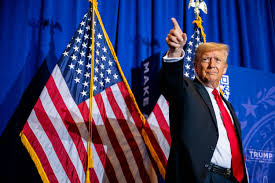
China’s Fiscal Plan Underwhelms; Trump’s Digital Enthusiasm Sparks Bitcoin Surge
In an interconnected world of global markets, China’s fiscal approach and U.S. policy shifts continue to reshape economic landscapes. Beijing’s latest fiscal measures, aimed at addressing local government debt, have left investors underwhelmed, with Chinese markets dipping amid disappointment over the absence of significant stimulus. Meanwhile, in the United States, President- elect Donald Trump’s endorsement of digital assets has ignited a surge in Bitcoin, pushing it to new heights and prompting fresh debate on the impact of political support on cryptocurrency markets.
Beijing’s Debt Strategy Falls Short of Market Expectations
In response to mounting local government debt, the Chinese government unveiled a debt resolution package valued at approximately 10 trillion yuan (£1.14 trillion). This plan, announced by China’s Ministry of Finance, involves six trillion yuan in special refinancing bonds to be issued over three years, while the remaining four trillion yuan will be allocated to local government bonds across five years. Aimed at reducing hidden debt, the measure was anticipated as a potential catalyst for China’s sluggish economy. However, the response from investors has been lukewarm, with the Hang Seng Index falling 2.3% and Chinese equities facing continued pressure.
Analysts attribute this lacklustre market response to the absence of comprehensive stimulus. Though the plan addresses debt restructuring, it stops short of directly stimulating domestic consumption or supporting the property sector—two areas of concern in China’s economic slowdown. Tom Rafferty, an economist with The Economist Intelligence Unit, noted, “While the debt relief is positive, it lacks the broader fiscal stimulus needed to revive growth in sectors that are currently suffering.”
Beijing’s cautious approach to fiscal spending follows years of aggressive investments that have left local governments facing high debt levels. The debt relief package does attempt to address this, with the Finance Ministry estimating a potential reduction of 12 trillion yuan in local government debt, freeing up 600 billion yuan in interest payments for economic investment. Yet, market analysts argue that without additional measures, such as direct consumer incentives, this relief plan may not translate into meaningful economic growth.
Inflation Remains Low, Deepening Economic Concerns
Compounding concerns surrounding China’s fiscal measures is the country’s ongoing struggle with low inflation. October’s Consumer Price Index (CPI) growth was a mere 0.3%, missing economists’ expectations and highlighting weak consumer demand. Additionally, the Producer Price Index (PPI) remained in negative territory for the 25th consecutive month, showing a 2.9% decline from the previous month, according to official data.
This trend of low inflation reflects the broader challenges faced by China’s economy. The lack of consumer demand has raised concerns among policymakers, who have cautiously shifted their stance towards supporting domestic consumption. Yet, the government’s reluctance to introduce sweeping fiscal stimulus measures, particularly for the property sector, has stoked fears that China’s economic growth may continue to falter.
Ming Ming, Chief Economist at CITIC Securities, commented, “China’s fiscal approach reflects a cautious stance that, while addressing debt concerns, may not do enough to stimulate overall growth. The economy is facing a complex set of issues, and consumer demand is a critical area that needs more attention.”
Trump’s Digital Asset Support Fuels Bitcoin Rally
In stark contrast to China’s cautious fiscal measures, the United States witnessed a surge in Bitcoin’s value following recent comments from Donald Trump endorsing digital assets. His stance, coupled with a supportive U.S. Congress leaning towards favourable digital asset policies, has propelled Bitcoin to a historic high of $81,000. This increase represents a 5.5% gain in just three days, with cryptocurrency markets riding high on investor optimism.
The U.S. cryptocurrency market’s response to political endorsement underscores the role of policy in shaping financial markets. Trump’s endorsement aligns with broader trends in the United States towards embracing digital assets, especially as regulations become clearer. This political support has galvanised the cryptocurrency community, with many viewing Trump’s backing as a signal for potential mainstream acceptance of Bitcoin and other digital assets. Market analysts highlight that the rally reflects increased confidence among retail and institutional investors in the long-term potential of cryptocurrency.
Financial analyst Mark Yusko from Morgan Creek Capital stated, “Trump’s comments have certainly catalysed Bitcoin’s surge, reflecting both political backing and a broader shift in market sentiment towards digital assets.” However, the rally’s sustainability remains uncertain, especially as the Federal Reserve’s upcoming policy decisions on interest rates could influence capital flows into high-risk assets like Bitcoin.
China-U.S. Tech Tensions Impact Semiconductor Sector
Adding to the economic complexities, U.S.-China relations around technology remain a sensitive area, with recent developments potentially escalating tensions. According to Reuters, the U.S. government instructed Taiwan Semiconductor Manufacturing Company (TSMC) to halt certain AI chip shipments to China. This move reflects Washington’s ongoing efforts to limit China’s access to advanced technology, which has implications for the semiconductor industry and broader tech markets.
TSMC’s compliance with the U.S. directive is expected to affect Chinese tech giants like Huawei, Baidu, and Tencent, which rely on advanced AI chips for their operations. The Hang Seng Tech Index and semiconductor-related stocks in China showed signs of pressure following this announcement, as investors anticipate potential disruptions in China’s tech supply chain. Geopolitical analysts suggest that the move aligns with the Biden administration’s focus on limiting China’s advancements in sensitive tech fields while fostering supply chain resilience in U.S. industries.
The Bigger Picture: Diverging Economic Paths
China and the U.S. appear to be charting divergent paths in their economic policies. While China maintains a conservative fiscal strategy prioritising debt control over aggressive stimulus, the United States embraces a more speculative financial landscape, with political support boosting sectors like cryptocurrency. These differences underscore the shifting dynamics in global markets and the influence of policy in shaping investor sentiment.
Despite the excitement surrounding digital assets in the U.S., economists caution against viewing cryptocurrency as a guaranteed haven. The Federal Reserve’s anticipated December rate cut decision and sticky inflation may alter capital flows. Furthermore, geopolitical factors, including U.S. tech restrictions on China and ongoing tariff concerns, add layers of uncertainty to an already complex market environment.
Looking Forward
As investors navigate these developments, the impact of China’s conservative fiscal approach and the U.S.’s pro-crypto sentiment highlight the challenges and opportunities within each economic sphere. While China’s debt plan has attempted to provide stability, markets appear unconvinced that this alone will stimulate growth in a complex economic environment. In contrast, Trump’s support for Bitcoin has spurred renewed interest in digital assets, revealing how political endorsements can influence market dynamics.
The coming months are expected to reveal more about each country’s approach. China’s economic trajectory may hinge on its response to consumer demand and potential adjustments to its fiscal policy, while the U.S. will watch the Fed’s policy decisions and regulatory developments closely. The diverging strategies not only highlight contrasting economic philosophies but also signal potential shifts in global financial markets.
Ultimately, these developments serve as a reminder of the interconnectedness of the global economy. How China and the United States choose to navigate their fiscal and regulatory environments could shape the economic landscape for years to come.
Aric Jabari is a Fellow, and the Editorial Director at the Sixteenth Council.



